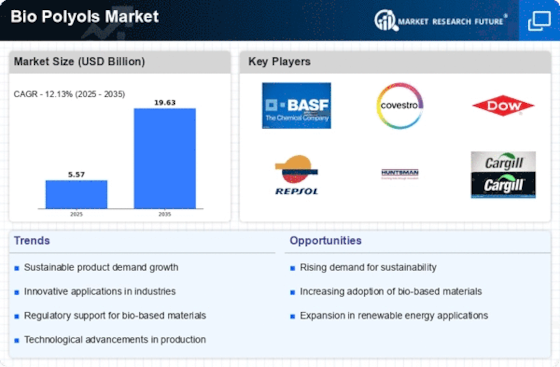Supportive Regulatory Frameworks
The establishment of supportive regulatory frameworks is a crucial driver for the Bio Polyols Market. Governments are increasingly implementing policies that promote the use of renewable resources and sustainable materials. For example, regulations that incentivize the use of bio-based products in various applications, such as insulation and adhesives, are likely to bolster market growth. These policies not only encourage manufacturers to adopt bio polyols but also create a favorable environment for research and development in this sector. As a result, the Bio Polyols Market may experience accelerated growth, with more companies seeking to comply with regulations while meeting consumer demand for sustainable products.
Innovations in Production Technologies
Technological advancements in the production of bio polyols are likely to enhance the efficiency and cost-effectiveness of manufacturing processes within the Bio Polyols Market. Innovations such as enzymatic processes and the use of renewable feedstocks are emerging, which could potentially lower production costs and improve product quality. For instance, the development of new catalysts and processes may enable manufacturers to produce bio polyols with higher purity and performance characteristics. This evolution in production technology is expected to attract more players to the market, thereby increasing competition and driving further innovation. As a result, the Bio Polyols Market may witness a surge in new product offerings and applications, catering to diverse consumer needs.
Rising Demand for Eco-Friendly Products
The increasing consumer awareness regarding environmental sustainability appears to drive the Bio Polyols Market. As consumers become more conscious of their ecological footprint, the demand for eco-friendly products, including bio-based polyols, is likely to rise. This shift is evident in various sectors, such as automotive and construction, where manufacturers are increasingly incorporating bio polyols into their products. The market for bio polyols is projected to grow at a compound annual growth rate (CAGR) of approximately 8% over the next few years, indicating a robust demand for sustainable alternatives. This trend not only reflects a change in consumer preferences but also suggests a broader movement towards sustainable manufacturing practices across industries.
Expanding Applications Across Industries
The versatility of bio polyols is driving their adoption across a multitude of industries, thereby propelling the Bio Polyols Market forward. Applications in sectors such as furniture, automotive, and construction are expanding, as manufacturers recognize the benefits of using bio-based materials. For instance, bio polyols are increasingly utilized in the production of flexible and rigid foams, coatings, and adhesives. This diversification of applications not only enhances market potential but also encourages innovation in product development. As industries continue to explore the advantages of bio polyols, the market is likely to witness a steady increase in demand, further solidifying its position in the materials landscape.
Consumer Preference for Healthier Alternatives
The growing consumer preference for healthier and safer alternatives is influencing the Bio Polyols Market. As awareness of the potential health risks associated with synthetic chemicals increases, consumers are gravitating towards products made from natural and bio-based materials. This trend is particularly evident in the food packaging and personal care sectors, where bio polyols are being integrated into formulations to enhance safety and reduce environmental impact. The market for bio polyols is expected to benefit from this shift, as manufacturers respond to consumer demands for transparency and sustainability. Consequently, the Bio Polyols Market may see a rise in product offerings that align with these health-conscious consumer trends.

















Leave a Comment